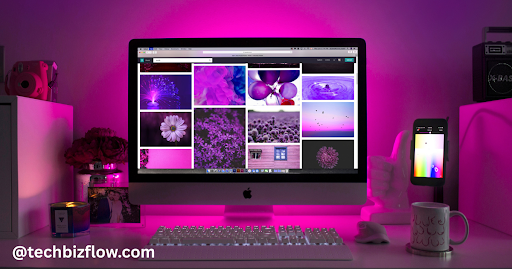Introduction: A Splash of Color in a Sea of Beige
In the late 1990s, desktop computers were useful but not yet in vogue. Most machines came in the same gloomy beige boxes. They did their job—crunching numbers, running spreadsheets, printing reports, but looked more like office apparatuses than individual companions.
Then, in 1998, Apple presented the iMac G3. It didn’t break the mold; it crushed it with a translucent, colorful plan and strong, specialized shifts that re-imagined the individual computer involvement.
The iMac G3 wasn’t fair in looks. It presented an innovative approach to computing: available, human-centric, and design-forward.
This is the story of how Apple’s perky, all-in-one desktop machine made a difference in shaping cutting-edge computing, from aesthetics to convenience, and made the individual computer feel genuinely individual again.
The Context Before the Revolution
The Beige Box Era
Before the iMac G3, domestic computers followed a reasonably standard equation: a screen, a tower, a console, and a mess of cables. The advertisement was overwhelmed by IBM-compatible PCs running Windows.
These machines were ordinarily bulky, subpar, and built more for trade than lifestyle.
Apple itself was battling in the mid-’90s. The company had fallen behind in advancement and planning. Its items were complicated, costly, and losing market share.
Steve Employment had been removed a long time prior, and the company had lost its way.
Then, in 1997, employment returned.
The Return of Steve Jobs
Steve Jobs‘ comeback marked a turning point. He brought with him a renewed focus on simplicity, design, and user experience.
One of his first major moves was to cancel dozens of redundant or The result was not at all like anything seen before.
performing products and focus Apple’s energy on a handful of impactful ones.
One of those items would have become the iMac.
Birth of the iMac G3
Designing the Future
Apple collaborated with British architect Jonathan Ive to reimagine what an individual computer might look like. The objective wasn’t to alter the shape—it was to rethink the relationship between people and machines.
The result was unlike anything seen before.
The iMac G3 highlighted a translucent plastic shell, permitting you to see the inside components.
It came in a striking Bondi Blue color, inspired by the water of Bondi Shoreline in Australia.
Afterward, Apple extended the lineup to incorporate different candy-like colors, turning the computer into a question of craving, not fair utility.
All-in-One Simplicity
Instead of isolating the screen and CPU, the iMac G3 combined them into a single unit.
This spared space and decreased clutter. It too a disentangled setup, just plug it in and go.
It was computing for individuals who didn’t need to think about specs, drivers, or configuration.
Even the mouse and console were overhauled. The “hockey puck” mouse, even though divisive in conception, looked cutting edge. The console was compact and translucent, coordinating with the computer’s shell.
Cutting-Edge Decisions

No Floppy Drive
One of the iMac’s boldest moves was the evacuation of the floppy disk drive. At the time, this choice was questionable.
Floppy disks were still broadly utilized for exchanging files.
But Employment and his group were accepted in the future. They pushed clients toward CD-ROMs and USB capacity in step.
This choice foreshadowed Apple’s afterward moves, like removing earphone jacks and optical drives.
In each case, the company wagered on rising advances or maybe than clinging to the past.
USB-Only Ports
The iMac G3 was among the to begin with standard computers to receive USB as the standard interface for peripherals.
Whereas PC clients were still managing with serial and parallel ports, the iMac went all-in on USB. This made a difference in popularizing USB over the industry and rearranged the adornment ecosystem.
Built-In Modem and Ethernet
The iMac G3 made it simple to get online. It came with a built-in 56k modem and Ethernet port—no add-on cards or setup required.
For numerous clients, this was their to begin with genuine encounter with the internet.

Marketing Magic
Hello (Again)
Apple’s showcasing for the iMac G3 was intelligent and troublesome. It utilized the expression “Hello (again)” as a callback to the unique Macintosh’s famous “Hello” from 1984.
The advertisements emphasized identity and fashion or maybe than fair performance.
Television commercials featured the iMac turning in space, set to energetic music. Magazine advertisements highlighted its color choices. The message was clear: this wasn’t fair a computer it was a statement.
Computers for the Rest of Us
Apple needed to make computing feel less specialized and more congenial. The iMac G3 was promoted to families, students, and creatives, not fair IT experts or corporations.
And it worked. The iMac became a social symbol nearly overnight. It showed up in motion pictures, on magazine covers, and in homes that had never claimed a computer before.
Inside the Machine
Hardware Specs
Under the hood, the iMac G3 was competitive, if not groundbreaking. The to begin with show featured:
- A PowerPC G3 proceLater models saw enhancements in CPU speed, illustrations, capacity, and indeed the presentation of FireWire ports for high-speed information transfer—great for video editing.
- ssor at 233 MHz
- 32 MB of RAM (upgradeable)
- A 4 GB hard drive
- A 15-inch CRT display
- A 24x CD-ROM drive
- Built-in stereo speakers
Later models saw improvements in CPU speed, graphics, storage, and even the introduction of FireWire ports for high-speed data transfer—great for video editing.
The Operating System
Initially running Mac OS 8.1, the iMac G3 afterward supported forms of OS 9 and early cycles of OS X. The user interface was custom-made to be intuitive.
Apple included instruments like AppleWorks and iMovie, empowering clients to make, not fair consume.
Chapter 6: Design That Changed the Industry
Influence Beyond Apple
The iMac G3’s perky plan had a swell impact on the tech world. Abruptly, customer gadgets didn’t have to be gray and boring. Everything from toasters to phones received straightforward plastics and striking colors.
PC producers took note as well. HP, Dell, and others attempted to discharge comparable colorful plans, but frequently needed the class and integration of Apple’s approach.
Birth of Tech as Fashion
The iMac G3 was an antecedent to the thought of innovation as a mold adornment. It made room for feeling and personality in tech items. This mentality would afterward educate the iPod, iPhone, and indeed the Apple Watch.
By treating innovation as a way of life, Apple set itself apart.
Education and the iMac
A Favorite in Classrooms
Schools rapidly grasped the iMac. It was simple to set up, tough, and didn’t require IT offices to spend hours designing drivers. The colorful plans made them neighborly and welcoming for students.
For an entire era of kids in the early 2000s, the iMac G3 was their to begin with involvement with a computer.
Multimedia Learning
With instruments like Kid Pix, iMovie, and GarageBand, the iMac became an inventive center in schools. Understudies might draw, record sound, and make recordings without requiring professional-grade equipment or software.
The Color Explosion
From Bondi Blue to Fruit Flavors
The unique Bondi Blue iMac was joined by a family of modern colors in afterward that long time, including:
- Lime
- Tangerine
- Strawberry
- Grape
- Blueberry
Each color had a title and identity. This gave clients a chance to select a machine that coordinated their style, an uncommon concept at the time.
Later models indeed came in more repressed tones like Graphite, Snow, and Indigo. Apple strives to walk the line between liveliness and sophistication.
Legacy and Impact
A Turning Point for Apple
The iMac G3 marked the start of Apple’s resurgence. It boosted deals, pulled in modern clients, and signaled a modern time of design-led development. It re-established Apple as a leader, not in computing control, but in imagination and client experience.
Laying the Foundation for the Future
Much of what characterizes Apple today—minimalism, integration, plan concordance, boldness to drop ancient tech—can be traced back to the iMac G3.
Without it, the iPod might not have been taken seriously. The iPhone might not have arrived as certainly. The iMac G3 instructed the world that plans matter—and that computing can be joyful.
Collector’s Item and Cultural Icon
A Nostalgic Favorite
Today, the iMac G3 is an adored collector’s item. Tech historical centers gladly show them. Vintage computer devotees reestablish them. A few indeed repurpose them as aquariums, lights, or retro TV shells.
Its charm remains undeniable.
Pop Culture Presence
The iMac G3 popped up in everything from “Legally Blonde” to “Sex and the City.” Its nearness in pop culture has cemented its famous status. It wasn’t a computer; it was an image of change.
Conclusion: The Computer That Made Us Smile
When the iMac G3 hit the showcase, it did more than boost Apple’s lineup; it started a bliss. It took something that had ended up gloomy and specialized and made it human again.
In a world presently overwhelmed by smooth aluminum chunks and near-invisible tech, the iMac G3 stands out as a strong, blissful update that computers can be fun, individual, and indeed a small bit magical.
Its bequest lives on in each item Apple discharges, and in the hearts of those who keep in mind the to begin with time they saw a computer that looked like a piece of art.
FAQs
What year was the iMac G3 released?
It was published in Eminent 1998.
Why was the iMac G3 important?
It changed how individuals saw computers, making them smart, user-friendly, and fun.
Who designed the iMac G3?
Jonathan Ive, under the authority of Steve Jobs.
Did the iMac G3 have USB ports?
Yes, it was among the to begin with standard computers to utilize USB exclusively.
What made the iMac G3 stand out?
It’s colorful, translucent plan and all-in-one simplicity.


